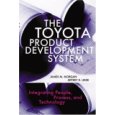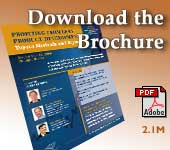
|
Keynote
Presentations |
|
|
|
| |
Tuesday,
October 14
Lean Concepts for Rapid Learning, Knowledge Capture and
Effective People Engagement |
 |
James Luckman
Partner
Lean Transformations Group, LLC |
|
| |
Over the past few decades,
many companies have applied lean tools and principles in
their operations. Most of the focus has been on
manufacturing but recently, there has been a movement to
the offices and also to product development. Many of
these lean efforts produced spotty results because the
implementation approach was limited by introducing lean
tools to the existing systems and culture of the
organization. It is clear that making the transformation
to a �Toyota-like thinking� company requires a very
different approach.
Product development is
about creating and capturing knowledge for reuse. The
core principles of lean involve engaging the entire
organization in solving problems around the products and
the processes so that the company can maintain and
continuously grow its knowledge. An effective
transformation approach in product development requires
key middle managers and engineers to participate in
rapid problem solving around their core development
processes. When lean concepts for rapid learning,
knowledge capture and effective people engagement are
applied, a new approach and focus for the entire company
can be achieved. Over time and through consistency of
this approach, many of the existing beliefs, mental
models, systems and behaviors change in favor of the new
knowledge-based paradigm.
Key
Takeaways:
-
Understanding of what has caused us to operate in
our existing paradigm and what is wrong with it
-
Learn what the new paradigm is and why it performs
at a higher level
-
Understand why product development is an ideal place
to begin the process of operating the new paradigm
-
Be informed of an
approach that has demonstrated the ability to create
this shift in thinking
Jim Luckman is a partner of Lean
Transformation Group, a company with experienced
practitioners of Lean and corporate coaches, focused on
helping companies manage a transformation to Lean.
Recently, Jim was the President and CEO of iPower
Technologies, a company serving the distributed
generation market of electrical power. In this position,
he successfully applied lean across all functions in the
organization providing a common change model. Jim has
worked in the auto industry for 34 years employed at
Delphi Automotive (formerly part of General Motors). He
has had significant experience in Strategic Planning,
Engineering and Manufacturing. In his most recent
position at Delphi, he was Site Manager at the Technical
Center of Rochester, NY, and Chief Engineer for Fuel
Systems. He led a transformation at the Technical Center
by adopting lean manufacturing principles and applying
Toyota product development principles. He took a systems
approach to making change and integrated this across all
functions that support the development process. As the
executive champion and change agent for Lean
Engineering, he spent most of his time coaching and
leading workshops for all Delphi Engineering
organizations and other interested companies. Jim has an
Electrical Engineering Bachelor's degree from Tri State
University and a Masters degree from Case Western
Reserve University in Computer Engineering. |
|
| |
Wednesday,
October 15
Second Generation Lean Product Development |
 |
Don
Reinertsen
President
Reinertsen &
Associates
and Author,
Managing the Design Factory |
|
| |

Many early attempts to
apply the principles of Lean Manufacturing in product
development have already fallen short. Organizations
often lose precious time doing value stream maps, waste
walks, and lean simulations in return for modest
improvements. Meanwhile, companies using more focused
approaches are getting 5 to 10x improvements in key
development activities. Lean looks very different in
product development, and these differences are the key
to capturing its benefits. In this presentation, Don
Reinertsen will discuss how practical methods like batch
size reduction, queue management, and cadence can make a
difference. Such methods are key to achieving large
simultaneous improvements in speed, quality, and
development cost.
-
Where did early
attempts to use Lean in product development go awry?
-
Why are queues the
underlying key to quality, efficiency, and speed?
-
How can we reduce the
cost of variability without stifling innovation?
-
Which lean methods
make a difference, and how do they work?
|
Don Reinertsen
is also the acclaimed instructor
of MRTs most popular workshop:
ACHIEVING LEAN
PRODUCT DEVELOPMENT:
Techniques, Economics and Implementation
Next Session: March 3-4, 2009 in San Diego
[MORE
INFO] |
Don Reinertsen is
President of Reinertsen & Associates, specializing in
the management of the product development process.
Before forming his own firm, he consulted at McKinsey &
Co., an international management consulting firm, and
was Senior Vice President of operations at Zimmerman
Holdings, a private diversified manufacturing company.
His contributions in the field of product development
have been recognized internationally. He is particularly
noted for bringing fresh perspectives and quantitative
rigor to development process management.
In
1983, while a consultant at McKinsey & Co., he wrote a
landmark article in Electronic Business magazine that
first quantified the value of development speed. This
article has been cited in the frequently quoted McKinsey
study that indicated �6 months delay can be worth 33
percent of lifecycle profits.� He coined the term �Fuzzy
Front End� in 1983 and began applying world class
manufacturing techniques in product development in 1985.
His book, Managing the Design Factory, is recognized as
a powerful and thoughtful application of manufacturing
thinking to product development. Don is also co-author
of, Developing Products in Half the Time. Mr. Reinertsen
holds a B.S. in Electrical Engineering from Cornell
University and an M.B.A. with distinction from Harvard
Business School. |
|
| |
Wednesday,
October 15
A Systems Approach to High Performance Product
Development in the Auto Industry |
 |
Abe Vadhavkar
GPDS Platform
Manager
Ford Motor Company |
|
| |
 Today�s
vehicles are arguably the most complex, technologically
advanced consumer products on the planet. They are
comprised of hundreds of thousands of individual parts
and thousands of interdependent, yet technologically
diverse subsystems that must work together seamlessly in
order to protect, transport, and entertain us. The
creation of these vehicles depends upon the development
of enormous, state of the art, high precision
manufacturing systems as well as the orchestration of an
intricate network of thousands of suppliers.
Consequently, a successful automotive product
development system requires the synchronized efforts of
an army of multi-disciplined engineers, scientists,
technicians and an array of business professionals
located across the globe. Today�s
vehicles are arguably the most complex, technologically
advanced consumer products on the planet. They are
comprised of hundreds of thousands of individual parts
and thousands of interdependent, yet technologically
diverse subsystems that must work together seamlessly in
order to protect, transport, and entertain us. The
creation of these vehicles depends upon the development
of enormous, state of the art, high precision
manufacturing systems as well as the orchestration of an
intricate network of thousands of suppliers.
Consequently, a successful automotive product
development system requires the synchronized efforts of
an army of multi-disciplined engineers, scientists,
technicians and an array of business professionals
located across the globe.
Further, all this must be
accomplished within a hyper-competitive environment in
which vehicle development times have shortened
radically, investment and variable costs have been
continually squeezed, quality expectations have risen
dramatically, and vehicle market segments have become
much smaller, and far more diverse. It is an intense
business, where hundreds of millions of dollars are at
stake in a single development project.
Competing in this business
requires serious commitment and a comprehensive, systems
approach to product development that includes talented,
highly skilled people, effective processes, and fully
integrated state of the art technologies. High
performance product development in the auto industry
depends upon a framework of guiding principles that
leverage these three crucial system elements. And the
best companies understand these principles, and how
people, processes and technologies can work together to
create a profound competitive advantage in product
development performance.
|
|
|

|
|
 �
Copyright 2008, All Rights Reserved, by �
Copyright 2008, All Rights Reserved, by
Management
Roundtable, Inc.
92 Crescent Street, Waltham, MA 02453 USA
Tel: 781-891-8080 or 781-891-8080 Fax: 781-398-1889 |
|

